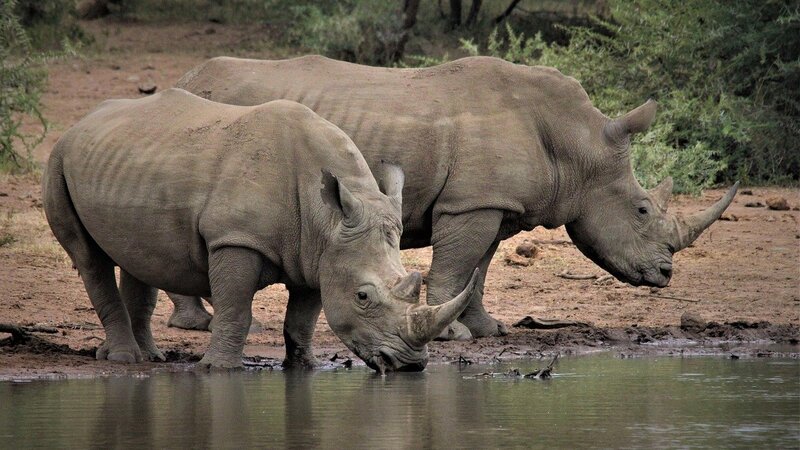We prepared a list of fascinating and interesting facts about rhinos, a wonderful, yet sadly dwindling animal species on Earth.
—
1. There Are Five Different Rhino Species
The five rhino species are: White rhinos, Black rhinos, Greater one-horned, Sumatran and Javan rhinos. Black and white rhinos are also known together as the African rhinos, as they are found only on the African continent. South Africa, in particular, is home to the largest population of white rhinos, with an estimated 18,000 in the wild. The other three rhino species can be found across Southeast Asia.
2. Rhino Horns are Made from the Same Materials as Human Fingernails
One of the most unique facts about rhinos is that their horns are made of keratin, which is also the same key protein that makes up human hair and fingernails. Their horns tend to grow and curve towards the head due to keratin at the front growing at a faster rate than it does in the back. Interestingly, if a rhino loses its horn – due to bulls fighting each other over dominance or territory – it will eventually grow back.
Black, white, and Sumatran rhinos have two horns, whereas Javan rhinos and Greater one-horned rhinos have only one. Horns can grow as long as 51 inches, most typically seen in the front horn of Black rhinos, while Javan rhinos have an average of 10 inch-horns.
3. Rhinos Heavily Rely on Scents to Communicate with Each Other
A rhino relies on its sense of smell quite extensively to either communicate with other rhinos or to mark territory. They would spray faeces and urine over certain areas or barks of trees to establish ownership, while avoiding places when they identify the scents of other rhinos. In some cases, a rhino stumbling upon a midden – another word for rhino dung – might walk through it and add its own dung to the pile to overtake the ownership of a territory.
4. Rhinos Love a Good Mud Bath
Rhinos have incredibly dark, thick hides and often require mud baths to protect their skin from the sun, parasites and most importantly, to maintain skin moisture. Mud would often stay on its skin after a bath, which helps rhinos stay cool throughout longer periods and when travelling across vast lands without shades. Rhinos could take up to two mud baths a day, with each session lasting up to three hours.
You might also like: Rhino Poaching Has Dropped Amid COVID-19, But What Does the Future Hold For the Species?

5. Rhinos Have Special Relationships with Birds
Another one of the many interesting facts about rhinos is that while they tend to be solitary animals, they have a symbiotic relationship with birds. This is most notable with the African rhinos and the African Oxpeckers. The bird would often sit on a rhino’s back and feed off the insects on it. Birds would also provide warning calls should any potential danger or enemies that approaches – as rhinos are quite short-sighted.
6. Three Rhino Species are Critically Endangered
The Black, Sumatran and Javan are listed as ‘critically endangered’ by the International Union for Conservation of Nature (IUCN). The Black rhino currently has an estimated population of about 5,627 in the wild, while Sumatran rhinos are dropped to less than 80 and Javan at a staggeringly low number of 75. This means these rhino species are literally at the brink of extinction.
The IUCN have been tracking conservation efforts of the various rhino species, and found Black rhino populations to be slowly recovering thanks to stricter regulation against poaching, increasing from an estimated 4,845 to 5,630 animals between 2012 and 2018. Greater one-horned rhino populations are rebounding in India and Nepal, surpassing 3,700 individuals. White rhinos, on the other hand, have declined by 15% between 2012 and 2017.
7. Rhinos are Poached for their Horns
One of the biggest drivers in population decline is rhino poaching, specifically for rhino horns. Much like elephant poaching for its tusks, rhino poaching boomed in the 1970s as rhino horns, or the ornamental dagger handles that are made from it, became a status symbol and luxury items. Rhino horns are also used in traditional Chinese medicine, and the demand for it remains high in Southeast Asian countries such as Vietnam and China.
Many conservation groups have dedicated their efforts to counter the threats of poaching and advocating for harsher sentencing for poachers. Since rhinos have the ability to grow back their horns, conservation teams have actively saw off rhino horns – after safely tranquillising them, of course – to prevent and deter poachers to target, as well as kill these animals in order to get their hands on rhino horns.
You might also like: Black Rhinos: Endangered Animals Spotlight


















